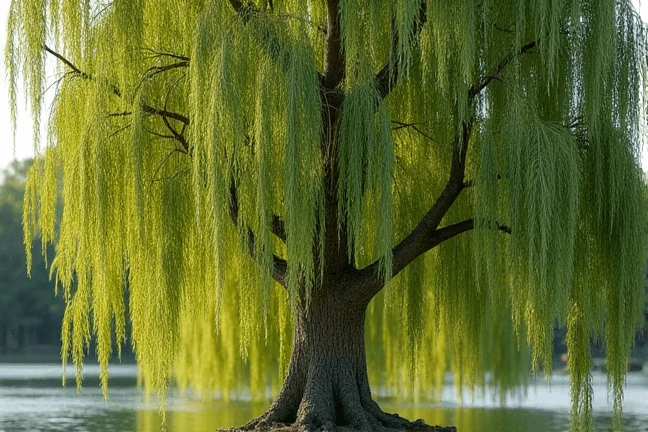
Weeping Willow
Salix babylonica
Grow Time
730-1095 days
Sunlight
Full Sun
Watering
Every 3-5 days
Toxicity
Mildly toxic
Video content from YouTube
Watch on YouTubeHow to plant Weeping Willow: Step-by-Step Guide
Growing Guide
Preparation

Hi there! Planting a Weeping Willow is an exciting project, but it’s important to get ready properly before you start. Let’s break it down step by step so you can set your tree up for success.
Choosing the Right Spot: Weeping Willows love water and sunlight, so pick a location that gets plenty of both. These trees thrive near ponds, streams, or other damp areas because their roots seek out moisture. Make sure the spot you choose has enough space—Weeping Willows can grow quite large, often reaching heights of 30-50 feet (9-15 meters) with wide, sweeping branches.
What You’ll Need:
- A young Weeping Willow sapling (or cutting)
- A shovel
- Compost or organic matter (to enrich the soil if needed)
- Watering can or hose
Timing: The best time to plant a Weeping Willow is in early spring when the soil is moist and temperatures are mild. If you live in a warmer climate, you can also plant in early fall. Avoid planting during extreme heat or frosty conditions.
Pro Tip:
If you’re planting near your home, make sure the tree is at least 50 feet (15 meters) away from any structures. The roots can spread far and might cause damage to pipes or foundations.
Planting

Alright, let’s get that Weeping Willow in the ground! Follow these steps carefully to give your tree the best start.
- Digging the Hole:
Dig a hole that’s about twice as wide as the root ball of your sapling but just as deep. This gives the roots plenty of room to spread out without being buried too deeply. - Prepare the Soil:
If your soil is heavy clay or very sandy, mix in some compost or organic matter to improve drainage and provide nutrients. Weeping Willows aren’t too picky, but they do appreciate good soil. - Position the Tree:
Place the sapling in the center of the hole. Make sure the top of the root ball is level with the surrounding ground. You don’t want to bury the trunk too deep. - Backfill and Firm:
Start filling the hole with soil, gently pressing it down as you go to remove air pockets. Don’t pack it too tightly—just enough to keep the tree stable. - Water Thoroughly:
After planting, give the tree a good, long drink of water. This helps settle the soil around the roots and starts the tree off on the right foot. - Mulch Carefully:
Spread a layer of mulch (like wood chips or bark) around the base of the tree, but keep it a few inches away from the trunk. Mulch helps retain moisture and keeps weeds down.
Tip:
If you’re planting a cutting instead of a sapling, stick the bottom end of the cutting into the soil about 6 inches deep, making sure at least two buds are below the surface. Keep the soil moist until roots develop!
Growing Care




Now that your Weeping Willow is planted, it’s time to focus on keeping it healthy as it grows. Here’s how to care for your tree:
Watering:
Weeping Willows need lots of water, especially during their first couple of years. Water deeply once or twice a week, depending on rainfall. If you live in a dry area, you may need to water more frequently. Once established, the tree will be more drought-tolerant, but it still prefers moist soil.
Pruning:
Prune your Weeping Willow in late winter or early spring before new growth begins. Remove any dead or damaged branches, and thin out crowded areas to allow light and air to reach the center of the tree. Be careful not to over-prune—this tree’s natural shape is part of its beauty!
Fertilizing:
You don’t need to fertilize your Weeping Willow often. If the growth seems slow, you can apply a balanced fertilizer (like a 10-10-10 mix) in early spring. But generally, these trees get most of what they need from the soil and water.
Dealing with Pests and Diseases:
Weeping Willows are pretty hardy, but they can sometimes suffer from pests like aphids or diseases like willow scab. If you notice yellowing leaves or spots, prune the affected areas and dispose of the cuttings. Keeping the tree well-watered and pruned will help prevent most issues.
Pro Tip:
Avoid planting flowers or grass directly under the Weeping Willow. The tree’s dense canopy and thirsty roots can make it hard for other plants to thrive nearby.
Harvesting

You won’t be “harvesting” anything from your Weeping Willow like you would with vegetables or fruit trees, but you can enjoy its beauty year-round! Here’s how to get the most out of your tree:
Enjoy the Shade:
As your Weeping Willow grows, its long, drooping branches will create a gorgeous, shady spot perfect for relaxing. Place a bench or hammock underneath and enjoy the peaceful ambiance.
Trimming for Decorative Purposes:
If you want to use some of the graceful branches for floral arrangements or crafts, you can trim a few here and there. Just be careful not to take too many, as excessive pruning can harm the tree.
Seasonal Beauty:
In spring, the tree will burst with fresh green leaves. In fall, those leaves may turn a lovely golden-yellow color before dropping. Each season offers something special to admire.
Tip:
If you want to propagate new trees, you can take cuttings from healthy branches in late winter or early spring. Stick them in moist soil, and with proper care, they’ll grow into new Weeping Willows!
Plant Care FAQ
Here are some common questions you might have while caring for your Weeping Willow:
Q: Why are the leaves turning yellow?
A: Yellowing leaves could mean your tree is getting too much or too little water. Check the soil—if it’s soggy, reduce watering; if it’s dry, water more often. It could also be a sign of a pest or disease, so inspect the leaves closely.
Q: My Weeping Willow is growing too close to my house. What should I do?
A: Weeping Willow roots can spread widely and may affect underground pipes or foundations. If the tree is too close, it’s best to consult a professional arborist to safely relocate or prune the tree.
Q: Do Weeping Willows lose their leaves in winter?
A: Yes, Weeping Willows are deciduous, meaning they shed their leaves in the fall and remain bare through winter. Don’t worry—new leaves will sprout again in spring.
Q: Can I plant a Weeping Willow in a small yard?
A: Not really. These trees need a lot of space to grow both above and below ground. If your yard is small, consider a smaller tree or shrub instead.
Q: How fast does a Weeping Willow grow?
A: Pretty fast! They can grow up to 8-10 feet per year when young, which is why it’s important to plant them in a spacious area where they won’t overcrowd other plants or structures.
Pro Tips
1. Go Natural
Weeping Willows look stunning when allowed to grow freely near water features. Their reflection in a pond or stream adds a magical touch to your landscape.2. Root Barrier Trick
To prevent roots from spreading too far, install a root barrier (available at garden centers) when planting. This can help protect nearby structures and pipes.3. Winter Care
Young trees may need extra protection during harsh winters. Wrap the trunk with burlap or use a tree guard to shield it from freezing winds.4. Enjoy Wildlife
Weeping Willows attract birds and other wildlife. You might find birds nesting in the branches or frogs enjoying the shade near the base of the tree.5. Prune Strategically
If the branches are touching the ground, you can trim them slightly to create a taller, more open canopy. This allows more light to reach the area beneath the tree.6. Companion Planting
While grass and flowers struggle under Weeping Willows, ferns and other shade-loving plants can thrive in the moist soil near the tree’s base.7. Fast Growth Alert
Because Weeping Willows grow quickly, they may require more frequent pruning than other trees. Stay on top of it to maintain the tree’s shape and health.